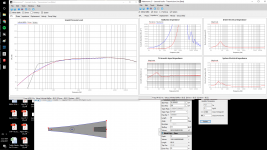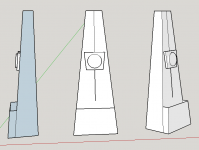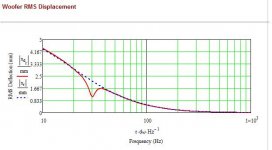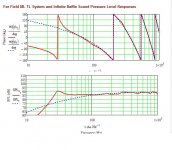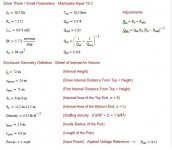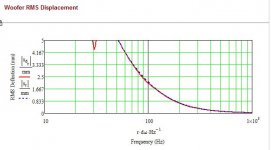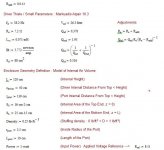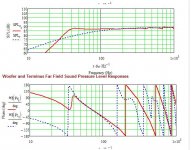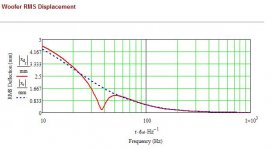My goal is to reproduce the lowest note of double bass, 41hz. This is above the FS of the driver, 38.3hz. Any thoughts?
A 'classic' ported alignment, the kind that yields a 'toe tapping' response, so works for me!
GM
Concerning loss of cone excursion control, you have to bear in mind that below the system's tuning frequency, the box stops controlling the cone's excursion which would lead to "unloading" resulting in wild cone excursion and the driver hitting xmax at very low power levels.
I like this article, animations for explaining this: Welcome Secrets of Home Theater and High Fidelity
GM
I like this article, animations for explaining this: Welcome Secrets of Home Theater and High Fidelity
GM
That's an excellent article that illustrates very well the issue at hand.
I will be bookmarking this one.
Thanks
What is the Fs for the 10.3m? The spec sheet only lists Fo. IIUC Fs is for free space and Fo infinite baffle. Also, how do I tell where Fb is on the graph?
Fo = Fs close enough for design purposes. Why? Your guess is as good as mine, though a design measurement routine to find Qo [similar, but not the same as Qts] that predates T/S filter theory is where it started AFAIK, though can't recall ATM who created it. The Japanese are the only ones still embracing it AFAIK.
Where the driver's deep notch is on the impedance plot.
GM
Version 3.0 hot off the presses w/sketchup mockup. Tuned to ~36hz. Idea here is to put the vent into the front panel and opening up the top (of the vent not the whole cabinet). Essentially, follow the shape of the front w/3" depth. Start area ~60"^2, end area ~45"^2, length 12". Overall the cabinet is 56" tall, base 10" x 20" (not counting the "port" which adds 3"), top is 7 3/8" x 4 3/8" keeps the same aspect ratio of the base. Also I kept the back 90 degree angle with the other three sides sloped. I've left the amp at 0.1 to hopefully allow for some room boom in the low end. So, theoretically, this could go against a wall. I've included sketchup files (just rename to *.skp)
*** note all measurements are internal.
*** note all measurements are internal.
Attachments
Last edited:
Count Sudoku, I have run your previous enclosure in Martin King's mathcad worksheet.
Check out the graphs below.
The last one represents the driver's excursion versus frequency at one watt (noting that excursion is RMS, meaning that to get actual excursion, multiply by 1.41)
the blue line is the driver in an infinite baffle, while the red line is the driver in the enclosure. As you can see, excursion control is minimal and over a relatively very narrow bandwidth.
Check out the graphs below.
The last one represents the driver's excursion versus frequency at one watt (noting that excursion is RMS, meaning that to get actual excursion, multiply by 1.41)
the blue line is the driver in an infinite baffle, while the red line is the driver in the enclosure. As you can see, excursion control is minimal and over a relatively very narrow bandwidth.
Attachments
Last edited:
Thanks. Help me understand... on the woofer RMS, chart 1w@20hz the cone is moving ~4.23mm one way (assuming RMS 3mm*1.41). Xmax for the 10m is 7.5mm one way. So, at 1w, the cone is still well within its specs. What would the graph look like at say 16w? Also, what does the dip at 30hz mean? More control, or less?
ok now this is interesting.... i put the pensil 10 and it has nearly the same curve (without the dip at 30hz) as the giant metronome. so, how then does this speaker not destroy itself with even modest power in a normal enclosure? One possible explanation I can think of is perhaps the software is showing displacement as total movement in which case the danger zone would be around 10mm on the graph.
If there's no/not enough room, boundary gain to offset it, then you'll likely hear its VC bounce off the motor's back plate on dynamic transient peaks and likely burn up the VC on a sustained low note.
That said, unless you like to occasionally listen to more bass heavy music than orchestral, then you'll probably be able to listen louder than you want to since the most power is concentrated in the 125-500 Hz BW where the driver has much more excursion/Hz available, with the 250-500 Hz requiring the most by far, up to 1 k times in reality [+30 dB], though clipped to a lower limit on a CD.
Crank up PF's DSOTM or even Ray Brown's, Christian McBride's, Brian Bromberg's or similar string bass CDs and the driver's VC will do a tap dance off the back plate ['been there done that' with some early MA drivers while trying to find the best balance between Fb, peak SPL], so hope they're still built 'Ford tough' as it didn't seem to faze mine.
Note that the upside to MA's high Xmax for such small drivers comes at the expense of no audible warning it's about to bottom out like a typical 'spider' driver that gives increasing distortion with increasing excursion.
GM
That said, unless you like to occasionally listen to more bass heavy music than orchestral, then you'll probably be able to listen louder than you want to since the most power is concentrated in the 125-500 Hz BW where the driver has much more excursion/Hz available, with the 250-500 Hz requiring the most by far, up to 1 k times in reality [+30 dB], though clipped to a lower limit on a CD.
Crank up PF's DSOTM or even Ray Brown's, Christian McBride's, Brian Bromberg's or similar string bass CDs and the driver's VC will do a tap dance off the back plate ['been there done that' with some early MA drivers while trying to find the best balance between Fb, peak SPL], so hope they're still built 'Ford tough' as it didn't seem to faze mine.
Note that the upside to MA's high Xmax for such small drivers comes at the expense of no audible warning it's about to bottom out like a typical 'spider' driver that gives increasing distortion with increasing excursion.
GM
One possible explanation I can think of is perhaps the software is showing displacement as total movement.........
No, it's one way [Xmax] unless some other value is inputted. As I just posted/implied, it's about the recording's music power distribution, room gain, average Vs peak power SPL at the listening position.
GM
ok now this is interesting.... i put the pensil 10 and it has nearly the same curve (without the dip at 30hz) as the giant metronome. so, how then does this speaker not destroy itself with even modest power in a normal enclosure? One possible explanation I can think of is perhaps the software is showing displacement as total movement in which case the danger zone would be around 10mm on the graph.
Funny you should mention that since I just pulled up a simulation of the Pensil I had done a couple of years ago.
And indeed the low frequency peak is there and cone excursion is crazy.
So who knows, maybe you could get away with such an alignment after all.
It is to be noted that I have a pair 10.2 pensils that's been my main stereo system for the past two years and while they are not the "cleanest" in the lower two octaves (this title would go to the trapezoidal Mar-Ken 10.2), they play Rock pretty well.
Here is my take on a metronome for the 10.3
I am sure it can still be refined.
As you can see, it ended up being quite smaller and shorter than the previous iterations.
I am sure it can still be refined.
As you can see, it ended up being quite smaller and shorter than the previous iterations.
Attachments
Hey guys,
I finally got through my other projects and have been building a set of metronomes (see attachment for the LA file that I based my design). So far I have 1 prototype made from 3/4 maple veneer ply from one of the big box stores. I pin nailed all the panels together and mounted the speaker to give it a test run. I did not do a 45 degree rout on the back side of the driver hole, also didn't stuff with anything or glue (so the box probably wasn't sealed as well as it should be). I had broken in the driver with about 100hrs of 1st mvt of Brahms Symphony #2. The general consensus of the sound was that it had a nice range but was missing warmth particularly in the mid range. I know a very subjective analysis. So here's a couple questions:
1) What can I do to warm up the sound. (Note that I have already done a 45 degree chamfer on the back side of the driver hole. I also plan to glue all the sides except the back panel to allow access to mess with stuffing. Also plan to stuff with ~1/2# of polyfill stuffing. And am going to experiment with adding 2-6 ohms resistance.)
2) Is it possible to measure the frequency response of the cabinet without spending a small fortune on equipment? If so, how? I do have a microphone.
Reminder: attachment is a Transmission Line file. So change the extension to "tlp"
I finally got through my other projects and have been building a set of metronomes (see attachment for the LA file that I based my design). So far I have 1 prototype made from 3/4 maple veneer ply from one of the big box stores. I pin nailed all the panels together and mounted the speaker to give it a test run. I did not do a 45 degree rout on the back side of the driver hole, also didn't stuff with anything or glue (so the box probably wasn't sealed as well as it should be). I had broken in the driver with about 100hrs of 1st mvt of Brahms Symphony #2. The general consensus of the sound was that it had a nice range but was missing warmth particularly in the mid range. I know a very subjective analysis. So here's a couple questions:
1) What can I do to warm up the sound. (Note that I have already done a 45 degree chamfer on the back side of the driver hole. I also plan to glue all the sides except the back panel to allow access to mess with stuffing. Also plan to stuff with ~1/2# of polyfill stuffing. And am going to experiment with adding 2-6 ohms resistance.)
2) Is it possible to measure the frequency response of the cabinet without spending a small fortune on equipment? If so, how? I do have a microphone.
Reminder: attachment is a Transmission Line file. So change the extension to "tlp"
Attachments
I am sure it can still be refined.
Looks fine to me since it doesn't need much damping to sufficiently smooth it out.
GM
Here's some pics of the prototype.
An externally hosted image should be here but it was not working when we last tested it.
An externally hosted image should be here but it was not working when we last tested it.
Until all the panels are sealed (oe glued) any comments or evaluation are probably premature.
The A10.3 really takes a long time to break ins 100 hrs is not near enuff and just enuff to get you to the point where they can start to be turned up.
Hard to say what you mean by warm, but in my mind i think A10p.
dave
The A10.3 really takes a long time to break ins 100 hrs is not near enuff and just enuff to get you to the point where they can start to be turned up.
Hard to say what you mean by warm, but in my mind i think A10p.
dave
- Status
- This old topic is closed. If you want to reopen this topic, contact a moderator using the "Report Post" button.
- Home
- Loudspeakers
- Full Range
- Metronome for Alpair 10.3m and 12p
